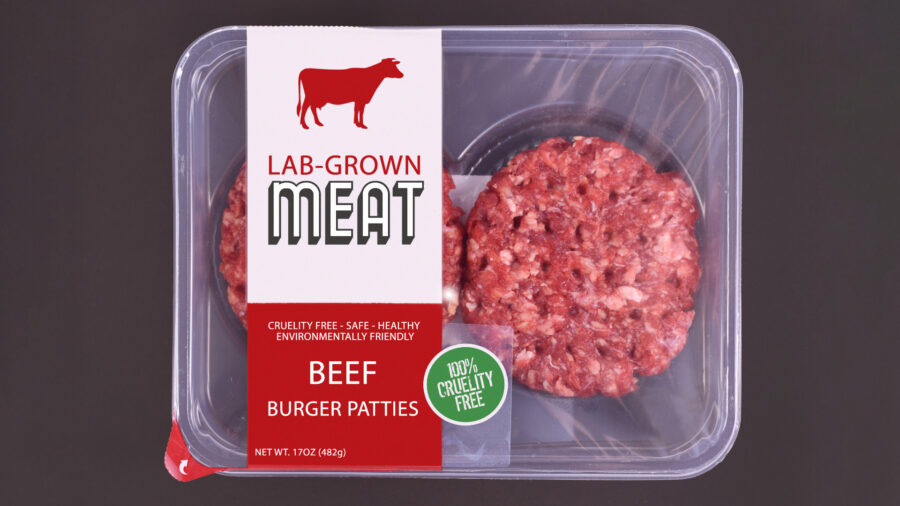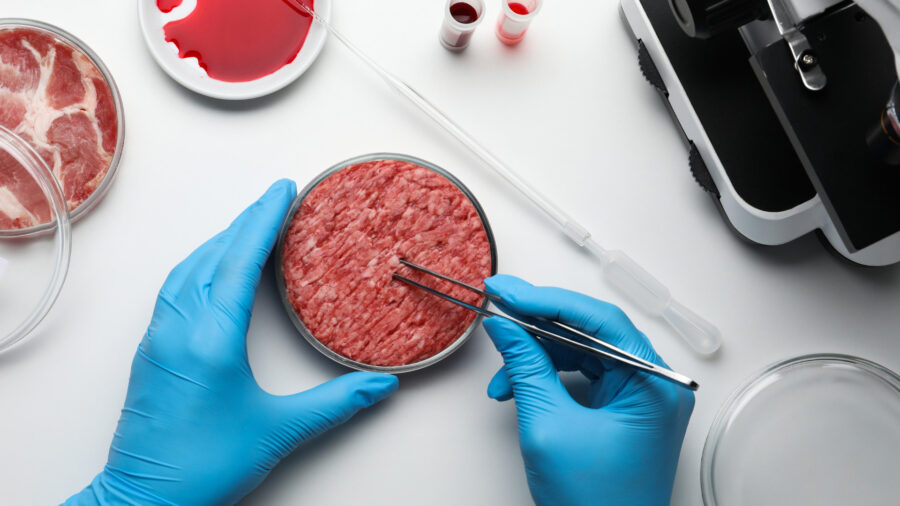No matter where you stand on cell-cultured food or how you decide what to put into your body, lab-grown and 3D-printed food is real, out there, and developing new and more scalable techniques to get to market with every passing day.
A new intradepartmental study from the University of California, Davis, however, may pump the brakes a bit on some of the pro-cell-cultured food community. Its conclusion: lab-grown meat may be up to 25 times worse for the environment than natural, pasture-raised cattle/retail beef.
The study has yet to be peer-reviewed. Nonetheless, it’s been making waves across the food industry due to its approach to the subject matter; by analyzing the known CO2 emissions from the in-lab purification process, the study concludes that the global warming potential of cultured meat is between four and possibly 25 times higher than that of traditional retail beef.
“The animal cell growth medium was the major driver of the environmental impact in our work. We examined scenarios which took into the account the purification/refinement of the growth medium and scenarios which did not account for the purification/refinement of the growth medium. My initial reaction was that our study highlighted the need for development of an animal growth medium that is less refined than pharmaceutical-grade and can support cell densities (cells/ml) that will be commercially viable for animal cell-based meat,” said Derrick Risner, PhD, MS, an IIFH Innovator Fellow with UC Davis, in an e-mail to The Food Institute.
The lab purification process to remove endotoxins is resource-heavy and intrinsic to boneless meat production, but current technologies are simply neither efficient enough nor environmentally scalable for a market that may not be quite ready to embrace the end product anyway. (It also bears mentioning that no conclusive study nor evidence exists that lab-grown meat presents any real health issues.)
“Our results indicate that ACBM [animal cell-based meat] is likely to be more resource-intensive than most meat production systems,” the authors wrote. By focusing on the most common aspects of cell-cultured production, the authors attempted to present the most balanced conclusion possible and help establish a new, more realistic metric by which to judge this brave new world of food science.
Lab-grown meat is only currently approved for retail sale in Singapore. It is estimated that lab-grown meat could be found in American restaurants by the end of 2023, however, and in grocery stores and retail centers by 2028.
The study cites that the fossil fuel requirements associated with purifying cell-cultured meat are between three and 17 times greater than that of traditional retail beef. The study also explains that past measures of environmental feasibility for cell-cultured meat have relied on technologies that either don’t exist or whose efficacy is specious at best. Thus, many past analyses have jumped the shark a bit, as their methods of comparison aren’t nearly as viable in the real world anyway.
“If companies are having to purify growth media to pharmaceutical levels, it uses more resources, which then increases global warming potential,” said lead author and doctoral graduate Derrick Risner, UC Davis Department of Food Science and Technology. “If this product continues to be produced using the ‘pharma’ approach, it’s going to be worse for the environment and more expensive than conventional beef production.”
Boon or Bust for Global Culture?
Some communities are opposed to cell-cultured meat from a purely cultural perspective. The government of Italy, for example, is considering a bill banning cell-cultured meat entirely from its borders. Francesco Lollobrigida, Italy’s Minister of Agriculture, took to social media to decry the unknown future of lab-grown meat.
“Italy is the first nation free from the risks of synthetic foods,” he wrote. “In defense of citizens’ health, of our production model, of our quality, of our culture, simply our FOOD SOVEREIGNTY,” he continued. Under the proposed bill, anyone who violates the ban on lab-grown meat could face a fine of €60,000 (approximately $65,022 USD).
The report states: Despite the highly limited availability of ACBM products, investment in ACBM companies has continued to increase, with a total investment of over $2 billion (as of 2021). This investor excitement is likely linked to analysts’ reports which are bullish on meat alternatives with some reports predicting a 60-70% displacement of ground beef by 2030-2040. … More recent reports seem to be more modest with their predictions of replacing a half of a percent of conventional meat products with ACBM products by 2030. With 12.6 billion kg of beef produced in the United States in 2021, even this more conservative estimate of predicted displacement would have a massive impact on the food system.
Astrophysicist Neil DeGrasse Tyson once said that the thing about science is that it’s true whether you believe in it or not. As impartial professionals, one of the goals of the study is to help define a future where cell-cultured meat is viable and can represent an efficient and environmentally friendly option to help feed the masses. If proper technology and facilities can be developed to lessen the current emissions costs of lab-grown products, then yes, the research team found cultured meat to be much more environmentally competitive and with a potential wide range of applications. Today, though, the scientific/environmental/cultural jump “from pharma to food” remains an expensive and taxing endeavor for mother Earth.
The report concludes, “Investing in scaling this technology before solving key issues like developing an environmentally friendly method for endotoxin removal…would be counter to the environmental goals which this sector has espoused.”
And it’s big business. The global cultured meat market was valued at over $180 billion in 2022 and is estimated to grow at a CAGR of 23.2% through 2032, reaching over 1 trillion by the next decade.
In Jurassic Park, proprietor John Hammond spared no expense and famously argued that “Creation is an act of pure will.” What the UC Davis study gets to is that yes, this technology exists and is potentially life changing for millions of people around the globe, both in the food industry, pharmaceuticals, and possibly other unknown applications. Whether or not the industry and its consumers are prepared to embrace that kind of creation – and its ensuant change and cultural shift amid consumers – remains to be seen.












